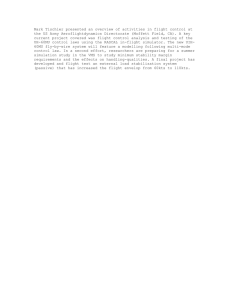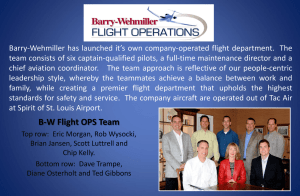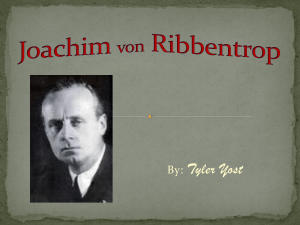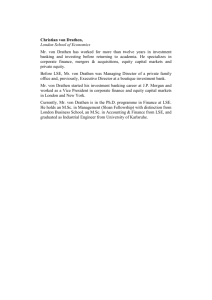Aero-Engines 1903-2003 - Toulouse Branch
advertisement
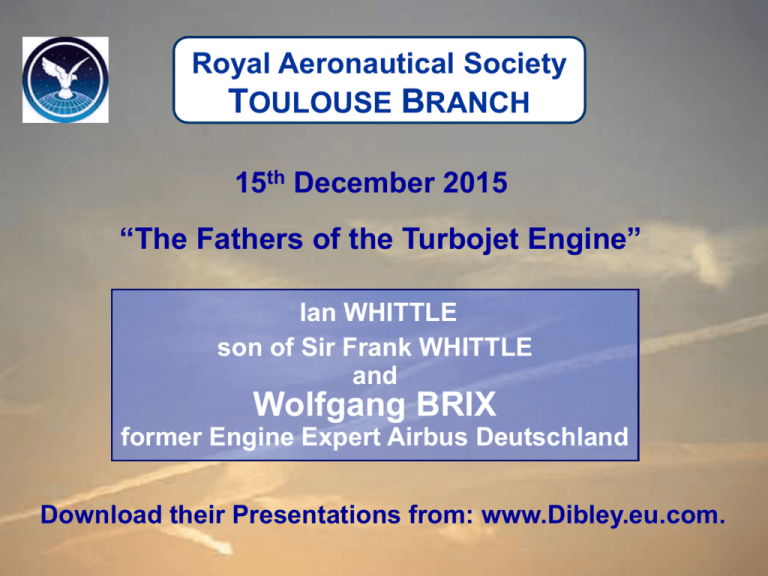
Royal Aeronautical Society TOULOUSE BRANCH 15th December 2015 “The Fathers of the Turbojet Engine” Ian WHITTLE son of Sir Frank WHITTLE and Wolfgang BRIX former Engine Expert Airbus Deutschland Download their Presentations from: www.Dibley.eu.com. Ian Whittle & Wolfgang Brix with their RAeS Toulouse Branch Speakers’ Tankards. Download their Presentations from: www.Dibley.eu.com. Ian WHITTLE Son of Sir Frank WHITTLE Learned fly at school aged 17 through Government Flying Scholarship 5 years in Royal Air Force flying Meteor & Hunter jet fighter aircraft 1958 Kuwait Airways based in Bierut on B707 & Hawker Siddeley Trident 1969 Cathay Pacific in Hong Kong on Convair 880, TriStar & B747 After active flying instructed for Cathay on the B747 Flight Simulator Fellow of the RAeS, Master Pilot of the Honorable Company of Air Pilots Still flies his own light aircraft Piper Archer from the UK to France Genesis of the Turbojet 4 Rolls-Royce Trent 1000 Turbofan 5 8 9 Dr Griffith (RAE) advises Air Ministry that idea has insufficient merit to warrant further research 11 1930/31 • Turbojet patent • Air Ministry remain disinterested and fail to apply secrecy • Aero gas turbine work at RAE ceases 12 1931/32 Turbojet enters the public domain ? ? 1930 - 34 Turbofan Turbofan 14 Reheat 1934 - 1936 F.W. at Cambridge (Peterhouse) May 1935 - turbojet rescued from oblivion 16 Col Tinling & Rolf Williams c1936 17 1936 - back into the fray Power Jets Ltd. Royal Aircraft Establishment 18 1935-1936 Germany Hans von Ohain Herbert Wagner Hermann Oestrich 19 20 21 22 1939 - Germany First Flight of a Turbojet aircraft He.178 Rocket • Turboprop • Turbojet • Ducted Fan • Pulsejet • Ram Jet 23 24 May 15th 1941 First Flight of the Gloster E28/39 Flight duration: 17 minutes Cleared for 10 hours of flight test before engine inspection 25 26 Gloster E28/39 27 28 1941 - The W1 sent to the USA (In 1940, the NAS had condemned the Gas Turbine Engine as unsuitable for aeronautical applications!) 29 30 31 Wolfgang BRIX Engine expert in Bremen for VFW-Fokker / Airbus Deutschland 36 years Studied & made calculations for all Airbus engines – Visited Toulouse more than 70 times 2005 Retired - made an archive of all his material, 2008 Wrote about all the engines in his life. Presented in 1989 München Symposium “50 Years of Turbojet flight” 1989. The fathers of the turbo jet engine A presentation by Wolfgang Brix (Germany), Engine expert Airbus Deutschland and Ian Whittle (Great Britain), Son of Sir Frank Whittle 1 1 The first gasturbine of Aegidius Elling On June 27th, 1903 the Norwegian Aegidius Elling writes in his diary : „I have made the worlds first gas turbine which has given positive (excess) power.“ Ellings gas turbine from 1903 : Temperature at turbine entry : 400°C Power : 11 hp The test installation can still be seen in the Norwegian Technical Museum in Oslo 2 2 The first jet engine ideas René Lorin (1877–1933) 1913 Patents by Frenchman René Lorin 1909 Patents by Frenchman M.George Marconnet All patents have in common: They do not show the power unit to drive the compressor. 3 3 The first jet flight of Henri Coanda 1910 Air Exposition in Paris The Romanian Henri Coanda shows an aircraft without propeller. Below: on the table a part of the engine, inscription: Turbine Propulsive 50 hp. 1911 : Coanda gets a patent for a „Propulseur“. 4 3 The first jet flight of Henri Coanda Henri Coanda (1886-1972) "It was on 16 December 1910. I had no intention of flying on that day. My plan was to check the engine on the ground …..I did not realize that the aircraft was rapidly gaining speed. Then I looked up and saw the walls of Paris approaching rapidly. …. I decided to fly instead……The aeroplane seemed to make a sudden steep climb and then landed with a bump. First the left wing hit the ground and then the aircraft crumpled up. I was not strapped in and so was fortunately thrown clear of the burning machine". This was the first jet flight in history ! 5 4 The patent of Maxime Guillaume 1922 A first impression of a turbo jet engine is given by patent No 534.801 of Frenchman Maxime Guillaume, filed on 3rd May 1921, granted on 13th January 1922. The title was „Propulseur par reaction sur l’air“ = „Propulsion by reaction on air“. Guillaumes engine is not complete, inlet and nozzle are missing and he cannot describe exactly how it works. He does not know the words nozzle, jet, jet velocity, mass flow, gross thrust, ram drag, net thrust. 6 6 The book of Aurel Stodola Prof. Aurel Boreslav Stodola born 10.5.1859 in the Slowakei, died 25.12. 1942 in Zürich This is Stodolas book about Steam+Gas Turbines. It is published from 1905 to 1927 in 6 editions and in 5 languages, this 1000-pages book becomes the bible of all steam and gas turbine engineers. 7 6 The book of Aurel Stodola Sir Frank Whittle knows and owns the Stodola book. The Nernst Turbine appears even in Whittles book “Gas Turbine Aero Thermodynamics“ . Dr. Hans von Ohain knows the Stodola book, as here he finds the Nernst Turbine, which becomes the starting point of his inventions. Sir Stanley Hooker, later chief of Rolls-Royce and Bristol Engines, starts his career with the study of Stodolas book. The Nernst turbine in Whittles book, left and in Stodolas book, right These 3 men found their inspiration in this book of Stodola 8 7 Alf Lysholm Lysholm‘s vita : 1893 December 14 born in Stockholm 1917 Employed by Ljungström 1928 Chief engineer Main work on screw compressors Pressure ratio up to 4 Lysholm‘s German patent DE 710,082 from 1933. It covers a version with propeller and a version with pure jet. None of Lysholms ideas has ever been built. 9 8 Herbert Wagner and team Wagner’s vita : Herbert Wagner 1900-1980 1900 Born in Graz/Austria 1934 First idea of a turbo prop engine 1935 At Junkers : Chief of airframe development, work on long range aircraft 1936 1.April : Wagner presents first idea of a turboprop engine to: Max Adolf Müller and other engineers 1938 Design and construction of a pure turbo jet engine, but the Junkers engine department is not informed 1938 Wagner needs better materials (alloyed steels), he contacts the RLM, Göring and his team are surprised and upset, they demand the work must be done in the Junkers engine department . Wagner + team refuse They know that Prof Mader is against jet engines 1938 End of the year the team splits : Wagner + some go back to Berlin, Max Adolf Müller turns to Heinkel, who hires him and 15 other member s of the team. They start in October 1939 in Rostock the department of axial engines and produce the He S 011 with 1333 kp (2939 lb) thrust. This was the highest thrust of all German engines, but only a prototype. Max Adolf Müller 1901 - 1962 10 8 Herbert Wagner and team Patent DE-724091 Patented 14.Aug 1938 The RT0 14-stage axial compressor, annular combustion chamber, 2-stage turbine No independent run The RTI 12-stage axial compressor, annular combustion chamber, 2-stage turbine, reached only 6500 rpm instead of projected 12900 rpm Patent GB 495,469 British application 8.Feb 1937 German application was 1935 Both engines disappear 1939 without trace in history 11 9 Hans Joachim Pabst von Ohain Von Ohain’s vita : 14.12.1911 Born in Dessau 1924 Studies In Berlin Dr.Hans Joachim Pabst von Ohain 1911-1998 1934/35 Doctor thesis with Prof Pohl as doctor father : „An interference Light Relay for White Light“ 3.6.1934 First Patent , sold to Siemens for 3500 Mark 9.11.1935 Second patent: a turbo jet engine 12 9 Hans Joachim Pabst von Ohain The idea for elegant flight 1931 Hans von Ohain makes a flight with a Ju52 from Köln to Berlin His comment: „The propellers made a horrendous noise. The airplane rattled because It had piston engines. …So I said, „Well, gee, that isn‘t good“. As an physicist you can come up with another process.“ The first idea: A process without moving machinery : after some deeper consideration finds it to be impossible. The second idea: The Nernst turbine. He describes the „modified“ Nernst turbine: having a radial compressor back to back wih a radial turbine .... “I was aware of employing axial flow compressors and turbines... but as too complex and expensive for the beginning. “ 13 9 Hans Joachim Pabst von Ohain The first patent (only an application) The Nernst turbine from Stodolas book about Steam- and Gasturbines 1922 Patent No O. 21 822 XI/62b, Filed 15.Mai 1935, Never granted 14 9 Hans Joachim Pabst von Ohain The way to the second patent Nernst turbine 1 element 8 elements 2 elements 8 elements combined into 1 4 elements 8 elements The turbo jet engine patent 15 9 Hans Joachim Pabst von Ohain The second patent Geheimes Reichspatent 317/38 Filed 9 November 1935 Patent 10 Nov 1935 16 9 Hans Joachim Pabst von Ohain The garage model 1935 Construction of a demonstration model in the garage of Bartels & Becker in Göttingen with the help of Max Hahn, no self sustained operation, Prof. Pohl helps with various equipment and checks the theory, 1936 When von Ohains money is spent, Pohl says: You need industrial support, Whom shall I write to ? Von Ohain decides: to Ernst Heinkel ! The compressor Max Hahn and the garage model 17 9 Hans Joachim Pabst von Ohain The letter 3 March 1936 Prof.Pohl writes to Prof.Heinkel Heinkel invites von Ohain. On 17th March 1936 they meet in Heinkels Villa in Warnemünde at the beach of the Baltic Sea. 18 9 Hans Joachim Pabst von Ohain Ernst Heinkel Siegfried Günter Walter Günter Both twins - Project office Kurt Matthaes Test Dept. Karl Schwärzler Heinrich Helmbold Chief constructor Aerodynamicist On the next day they meet again in the company with Heinkels technical team. The reaction of the engineers: „The idea of a turbojet is already known, but no one has produced a practical one. ..perhaps the time has come to have another try on it.“ After a second meeting Hans von Ohain gets a contract with a salary of 300 Mark/month. Max Hahn is hired, too. On 15th April 1936 they start working at Heinkel. 19 9 Hans Joachim Pabst von Ohain The team (left to right): Max Hahn,Hans von Ohain, Wilhelm Gundermann – from Heinkel • • • • • First they try again the garage model, again no selfsustained operation They build a copy of the garage model with the capabilities of the Heinkel company, again no selfsustained operation They gain the impression that they need 6-12 months to solve the combustion problem They decide to proceed in two directions: 1. Build a hydrogen combustion facility and then a demonstration engine running with hydrogen 2. Develop a combustion chamber running satisfactorily with fuel The hydrogen model HeS-1, built 1936/37, first run Feb/March 1937, thrust 250 lb = 113 kp at 10000 U/min 20 9 Hans Joachim Pabst von Ohain The hydrogen model : when did it run first ? Ernst Heinkel: In his memoirs „Stormy Life“ he mentions : “...in a September night 1937 “ Hans von Ohain : On many occasions he stated: „ This date (September 1937) is definitely wrong. It was February/March 1937 “ Ian Whittle: There are some serious doubts….. My comment : We will never find out…. 21 9 Hans Joachim Pabst von Ohain The Hahn patent and the HeS3B Hahns patent The first drawing of the flight engine The final flight engine HeS3B Hahn has the idea to increase the size of the combustion chamber and locate it in the large unused space in front of the radial flow compressor. Advantage: the diameter of the engine is kept small. Disadvantage: the flow must change direction twice. 22 9 Hans Joachim Pabst von Ohain The flight engine HeS3B First the flight engine HeS3B was built 1938/39, first run was around March1939 Initial thrust was 350 kp (772 lb) ,later 500 kp (1102 lb) In May or July 1939 the first He3B was flight tested under a He118. Because of a fuel leakage it burnt after a landing , destroying engine and aircraft. The pilots Warsitz and Künzel can escape unharmed. 23 9 Hans Joachim Pabst von Ohain The He178 Above: photos of the second prototype V2 which never flew Above: this photo is a fake, some details are wrong. 24 9 Hans Joachim Pabst von Ohain The first flight of the He178 Date Starting time Start Sunday, 27 August 1939 Around 6:00 (Sunrise 5:08) 300 m rolling Max speed 600 km/h (?) Erich Warsitz flies 2 rounds Total flight time 6 minutes Both Heinkel and Warsitz later reported that the raising of the landing gear was attempted, but in vain. This is nonsense, the landing gear was fixed, they knew it. It was the first turbo jet flight in history 25 9 Hans Joachim Pabst von Ohain Short celebration after the first flight of the He178 Heinkel von Ohain Warsitz Heinkel von Ohain The second flight of the He178 : 1 November 1939 High officials from Berlin come : Udet + entourage During take off roll the fuel pump fails, Heinkel entertains the visitors with an opulent breakfast, after 2 hours a second successful take off is made and Warsitz flies for around15 minutes. When leaving the visitors seem unimpressed. 26 9 Hans Joachim Pabst von Ohain But around 2 months later Heinkel receives from the RLM the official assignment to develop a jet plane with 2 jet engines under the wing, the name is He280. One potential engine for the He280 is the HeS8 (right) a derivative of the HeS3B (left) It has a straight flow through combustion chamber, a much longer rotor between compressor and turbine and thus a smaller diameter. The HeS8 never reaches more than 600 kp (1323 lb) thrust. 27 9 Hans Joachim Pabst von Ohain First flight of the He280 is on 30th March 1941. For safety reasons the engine cowls are not attached. The second flight 6 days later is observed by Ernst Udet. He is excited and allows Heinkel to buy the Hirth Motoren Company, which means, he is now an engine manufacturer and may continue with his engine activities. Ernst Udet 1896 - 1941 On the second flight the engine cowls are closed. On the right photo Udet makes a seating test. End of the story: In March 1943 the He 280 is cancelled, the engines remain prototypes. 28 10 Anselm Franz Franz‘s vita : 1900 1.January born in Schladming, Austria 1918-1924 Studies in Graz 1936 Working on superchargers at Junkers 1939 Chief engineer for the turbo engine development After 1945 Working for Lycoming Dr. Anselm Franz 1900 - 1994 Me 262 First flight 18.7.1942 Top speed over 850 km/h (1004 km/h in one case) 1368 aircraft built Dr. Anselm Franz 1989 in München Jumo 004 AB Serie for Me262 Thrust 910 kp (2006 lb) Weight 850 kg PR 3.1 with 8 stages First run 6.8.1940 6000 units built 29 11 Hermann Östrich Östrich‘s vita : 1903 30.December born in Duisburg Studies in Hannover, Berlin 1926 Working for DVLR 1935 BRAMO in Berlin 1939 Chief engineer for the turbo engine development After 1945 Working for Snecma (Atar) Dr.Hermann Östrich 1903 - 1973 Arado Ar 234 V6 First flight 8.4.1944 Top speed of 234C 872 km/h 214 aircraft built BMW 003 A Serie for Ar234, He162 Thrust 800 kp (1764 lb) Weight 570 kg PR 3.1 with 7 stages First run 20.2.1941 700 units built 30 12 The whole German Story Thrust in lb HeS011 withAB Jumo 004 Serie:6000 Serie:700 BMW 003 HeS30 HeS8 HeS3B HeS1 1936 1937 1938 1939 First flight He 178 27.8.1939 1940 1941 First flight He 280 30.3.1941 1942 First flight Me 262 18.7.1942 1943 1944 First flight Ar 234 5.6.1943 1945 First flight He 162 6.12.1944 At the first day of war : 1 turbojet engine, at the last day : 6700 produced. 31 Ian WHITTLE son of Sir Frank WHITTLE and Wolfgang BRIX former Engine Expert Airbus Deutschland Questions? Frohes Fest und ein gutes Neues Jahr Merry Christmas and Happy New Year Bonnes Fêtes / Meilleurs Voeux Feliz Navidad & Feliz Aňo Nuevo God Jul och Gott Nytt År Forthcoming Programme For posters / any changes / updates www.RAeS-Toulouse.org www.Aerosociety.com and links to www.Academie-Air-Espace.com AAAf-MP@sfr.fr
